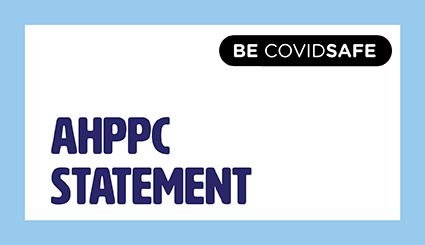
The Australian Health Protection Principal Committee (AHPPC) published a statement on the role of asymptomatic testing on 14 May 2020. Since then there has been an increase in cases of COVID-19. The increase has mostly been in Victoria, with community transmission occurring in the greater Melbourne metropolitan area. More recently, there has been limited community transmission in New South Wales. While most cases are linked to known outbreaks and clusters, there have been locally acquired cases with no known links to confirmed cases. There has been a rapid response to the outbreak, with an extensive public health effort and targeted testing.
Successful public health management of increasing case numbers and outbreaks in a region requires that testing must be carefully targeted to strike the right balance between maintaining epidemic control and protecting the sustainability of laboratory and testing site capacity.
In the context of the ongoing outbreak, it remains the view of AHPPC that large-scale, non-targeted, asymptomatic testing in Australia should be strongly discouraged. Non-targeted asymptomatic testing is neither epidemiologically sound nor a cost-effective approach to identify disease transmission. AHPPC acknowledges that there is a role for asymptomatic testing in specific contexts for disease control and surveillance purposes. These contexts include outbreak settings, populations of higher risk of transmission to low incidence areas, populations at significantly higher risk of exposure, and those in high risk transmission settings who are also vulnerable to severe disease if infected.
AHPPC continues to recommend that testing strategies, including workplace screening programs for asymptomatic people, be developed in consultation with relevant public health authorities and laboratory directors. This is to ensure the most appropriate and effective approaches are employed.
Background
The term ‘asymptomatic testing’ refers to a person who is not exhibiting symptoms at the time a test for SARS-CoV-2 is conducted. Asymptomatic individuals presenting for testing could either be:
- infected but have not yet developed symptoms (otherwise called ‘pre-symptomatic’); or
- infected but do not develop symptoms across the duration of their infection (otherwise known as ‘truly asymptomatic’); or
- not infected.
AHPPC recognises the essential role of testing in Australia’s approach to the control of COVID-19 and in preventing ongoing community transmission. Rapidly detecting and isolating people infected with SARS-CoV-2 (the virus that causes COVID-19), and quarantining their close contacts has a critical role in minimising transmission. A high testing rate across the population, particularly in specific contexts for disease control and surveillance purposes, is essential for detecting cases and providing confidence that cases will be detected.
The primary approach for identifying people with an active SARS-CoV-2 infection continues to be based on testing those with characteristic clinical symptoms. The rationale is that people with symptoms consistent with COVID-19 have a much higher probability of testing positive for SARS-CoV-2 than people without such symptoms. The Testing Framework for COVID-19 in Australia sets out prioritisation of testing in the following order:
- People with signs or symptoms consistent with COVID-19. This represents the primary approach for identifying people with active SARS-CoV-2 infection and the most important group on which to focus and increase testing.
- People with known exposure to SARS-CoV-2 (contacts) who may be in the incubation period for the disease.
- Asymptomatic people in high-risk outbreak settings (e.g. high density public housing, outbreaks in remote Aboriginal and Torres Strait Islander communities and age care settings, and meat processing plant and abattoirs (once a positive case is identified).
The testing framework also recognises there may be other circumstances where clinical and public health judgment leads to a decision to conduct asymptomatic testing. This includes:
- People at risk of exposure who present with atypical symptoms.
- At risk populations and settings where time limited testing may be used to provide an upper estimate of transmission in these groups or settings.
The COVID-19 CDNA National Guidelines for Public Health Units further outlines the process of investigating and follow up of such cases.
Non-targeted testing of asymptomatic people has several problems:
- In populations with low levels of COVID-19, the chance of detecting infection in a person without symptoms is very low. The number of asymptomatic people who would need be tested to identify just one case of COVID-19 is very high. This can be costly in terms of financial resources, personnel time and inconvenience to the people being tested.
- Asymptomatic people are less likely to be infected with SARS-CoV-2 than those with symptoms. PHLN advises that SARS-CoV-2 tests are very accurate, however, testing in asymptomatic individuals will result in a higher proportion of test results that are more difficult to interpret. In some instances, this may lead to the reporting of false positive results. A false positive test result can cause distress to the person, and their family, social contacts and workplaces. There are also financial impacts when an affected individual with a false positive result cannot work, their close contacts cannot work, and if associated businesses need to be shut down.
- If non-targeted testing of asymptomatic people is conducted at a large scale it could be counterproductive. Precious testing resources (e.g. chemicals and other consumables) and the services of skilled personnel (e.g. testers, contact tracers, data entry staff and epidemiologists) are wasted. Division of these resources can result in delays in diagnosis and isolation of true positive cases, and the identification and quarantine of contacts.
Read previous statements from the AHPPC.








